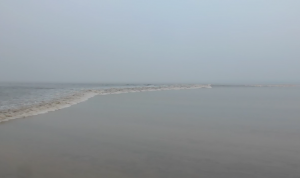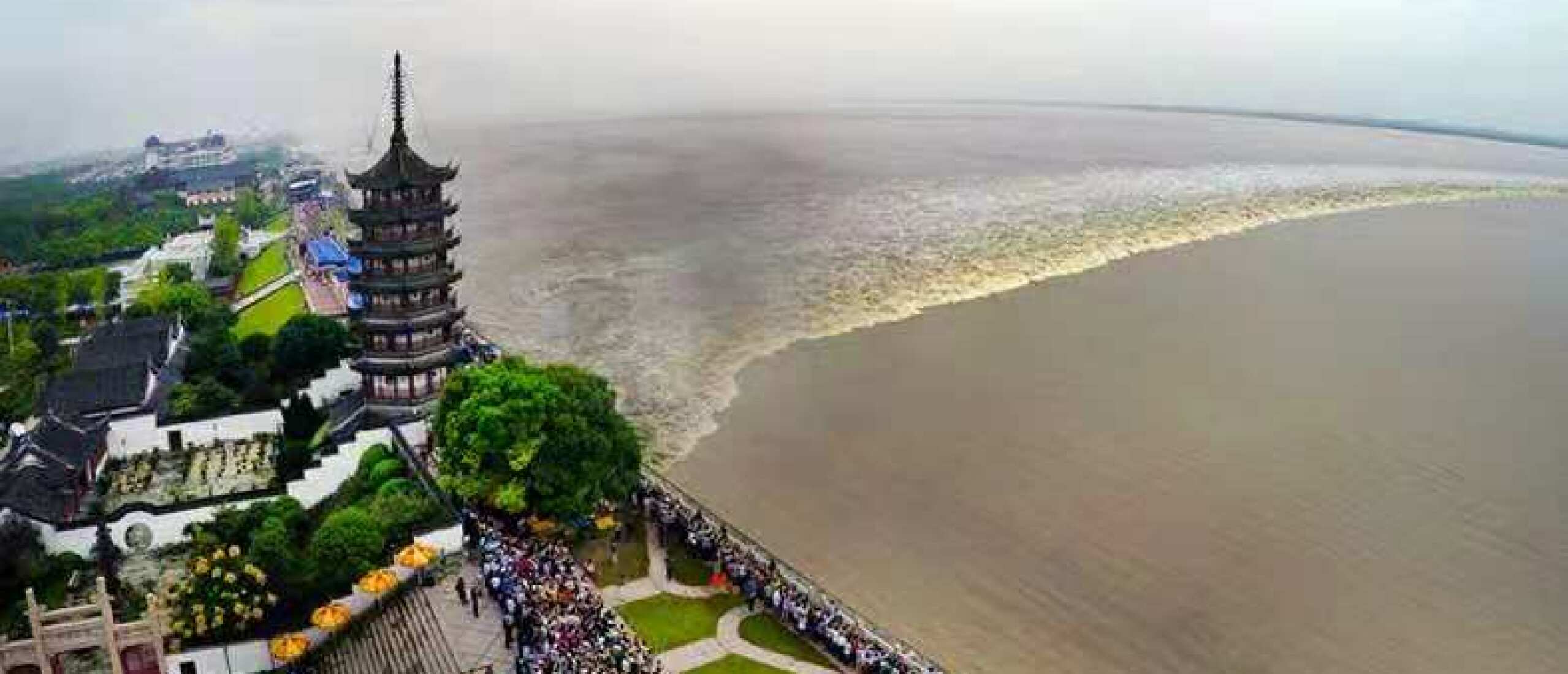
In the footsteps of J J Walker at Hangzhou and HainingPassing out of the gate, an exceedingly beautiful scene burst upon our view: in front of us lay the Si-hu or Western Lake, a fine sheet of water three miles by two in extent, almost surrounded by high rugged hills of volcanic character, well wooded in most parts, on one of which to our right, we could see the sanatorium, and, somewhat nearer at hand, a fine pagoda (the “Pas-shuh-ta”), built on a remarkably small base; another pagoda of larger size and more massive construction stood on the lower slopes of the hills on the opposite side of the lake to us. Many fishing and pleasure boats were passing over the smooth water, which appeared to be very shallow; it is crossed by two causeways, one of which joins the large wooded island of Wan-lau-ko to the shore; several smaller islands, all prettily wooded, were scattered about the lake, adding greatly to the beauty of the view. We proceeded towards the large island along the causeway, which was well paved in the middle with stone, a row of well-grown willows on either side, and about 30 feet in width. A very pretty “tea-house”, sat the end of the causeway, furnished a subject for photographers, and we continued along the lake shore, passing several fine temples and elaborately carved memorial gateways.
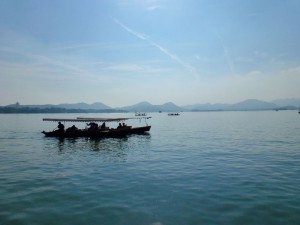 "Many fishing and pleasure boats were passing over the smooth water" of Hangzhou's beautiful Shi Hu
"Many fishing and pleasure boats were passing over the smooth water" of Hangzhou's beautiful Shi Hu
 "An exceedingly beautiful scene burst upon our view" - the West Lake at Hangzhou
"An exceedingly beautiful scene burst upon our view" - the West Lake at Hangzhou
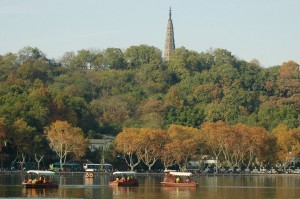 One of the two pagodas mentioned by JJW stands proudly, commanding one of the northern hills
One of the two pagodas mentioned by JJW stands proudly, commanding one of the northern hills
The above description is taken from the entry for 4th October, 1893, in the journal of J J Walker, brother-in-law of my great grandfather, G C Champion. “Uncle Jim”, as Walker was later known to the family, was serving as Staff Engineer on HM Surveying Ship “Penguin”, which had just completed taking the soundings around the nearby Chusan (now Zhoushan) archipelago, off the eastern China coast near Ningbo. J J Walker then embarked on a river and canal journey from Shanghai, together with his commanding officer, Captain W U Moore and a British photographer resident in Shanghai, a Mr B Q Cooper, first to Hang-chau (now Hangzhou) and then to Hai-ning to observe the extraordinary tidal bore that sweeps up the Qiantang river (then known as the Tsien-tang Kiang) at certain stages of the moon’s cycle. Last weekend, 24th and 25th November, 2018, I embarked on a journey with two friends to visit these locations for myself, using JJW’s writings as my guide, 125 years after his visit. As we approached the famed West Lake in Hangzhou, but as yet unable to see it as it is bounded by a thick belt of trees, we read the above description, and then walked towards the lake. Exactly as Walker describes, “an exceedingly beautiful scene burst upon our view”; the pleasure boats were there, as were the two pagodas he mentions, and we felt as if we had been transported back in time and were with Walker as we proceeded to retrace his footsteps around the beautiful West Lake, passing under many of the ancient trees that JJW had passed under 125 years before.
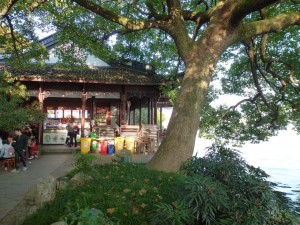 This venerable tree may have witnessed JJW sipping tea in this tea-room
This venerable tree may have witnessed JJW sipping tea in this tea-room
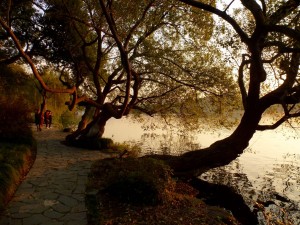 J J Walker passed by these ancient trees in 1893
J J Walker passed by these ancient trees in 1893
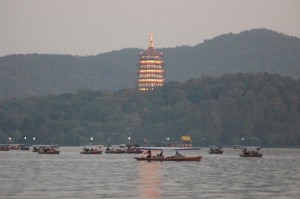 By now the larger pagoda was illuminated in the gloaming
By now the larger pagoda was illuminated in the gloaming
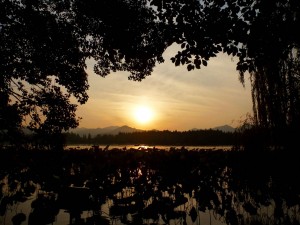 Hangzhou's West Lake is renowned for its sunsets
Hangzhou's West Lake is renowned for its sunsets
 Two boats head home in the evening light
Two boats head home in the evening light
 A panoramic map of the West Lake at Hangzhou
A panoramic map of the West Lake at Hangzhou
On the Sunday morning, we set off by car (unlike JJW and his team, who travelled by canal-boat) to the Haining Tidal Wave Observation Park, on the northern bank of the estuary of the Qiantang river. It was here that Captain Moore, J J Walker and the photographer Mr Cooper spent several days in October 1893, observing both the day and night bores that can best be seen here, although in fact they can even be seen as far inland as Hangzhou and sometimes even beyond. If only I could locate the photographs taken by Mr B Q Cooper; perhaps they still exist in an archive somewhere. Despite extensive research on the Internet, I had found it almost impossible to obtain accurate information as to precisely on which days and at what times this remarkable tidal phenomenon could be expected, so our arrival on this day was something of a gamble, and as there appeared to be virtually no other people entering the riverside park, it seemed that the prospects for seeing anything spectacular were poor.
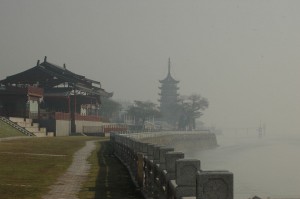 The tidal wave viewing park was tranquil in the morning gloom
The tidal wave viewing park was tranquil in the morning gloom
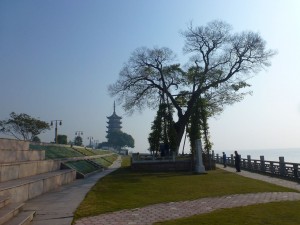 The weather improved until we could sit in the sunshine close to the pagoda that JJW had viewed from
The weather improved until we could sit in the sunshine close to the pagoda that JJW had viewed from
One advantage of the apparently low probability of seeing the bore that morning was the tranquility that we were able to enjoy. After a grey start, the weather was idyllic, a warm sun allowing us to sit peacefully basking near the pagoda from which J J Walker had observed the tidal bore all those years before. Although it was late November, I was able to enjoy perhaps my last observations of two species of butterfly mentioned by Walker in his journal, the Eastern Pale Clouded Yellow (Colias poliographus) and the Long-tailed Blue (Lampides boeticus).
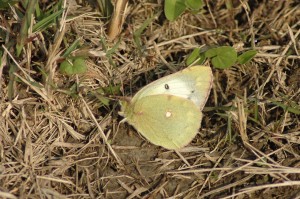 Both J J Walker and I observed the Eastern Pale Clouded Yellow while waiting for the tidal bore
Both J J Walker and I observed the Eastern Pale Clouded Yellow while waiting for the tidal bore
Offshore the fast-flowing current of the Qiantang river was producing a variety of unusual wave effects, including several equally spaced waves in long lines, some of which eventually broke, producing a low roaring sound that waxed and waned according to the size of the waves.
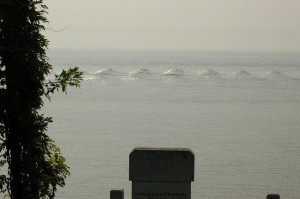 Some of the wave movements were unusual and fascinating
Some of the wave movements were unusual and fascinating
We savoured these sights and basked in perhaps our last moments of warm sunshine in 2018, in my case dreaming of the scenes that J J Walker had witnessed in precisely this spot 125 years earlier, but it appeared less and less likely that we would be treated to the sight of the Bore itself, so eventually we made our way towards the exit of the park at about midday. As we approached the entrance/exit gates, the man who had checked our tickets earlier made clear signs at us to stop, crossing his arms in front of his chest and pointing towards an illuminated neon sign on the wall, on which the time 13:10 had appeared. So there was going to be a wave that day after all. If he had not indicated this sign to us, we would never have known. We went out for a quick bite to eat, and returned to the riverside park at around 12:50. By this time the weather had changed, and the first drops of light rain were starting to fall, but this had not deterred the considerable numbers of bore-viewers who had by now assembled on the sea-wall, and already the distant roar of the wave could be heard, even though it was still 20 minutes away.
 Numbers of people had gathered to await the arrival of the Bore
Numbers of people had gathered to await the arrival of the Bore
As the appointed time approached, the volume increased, until at about 13:05 I had my first sight of the wave through my binoculars, just as JJW had through his telescope 125 years earlier. The wave advanced with considerable speed, until it swept past us, followed by turbulent, turbid water filled with churned up sand and mud.
 The impressive wall of the Bore as it approached. Photograph by Uwe Brunn
The impressive wall of the Bore as it approached. Photograph by Uwe Brunn
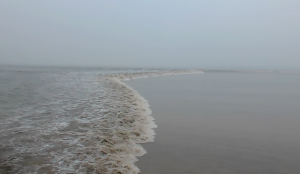 The Bore as it passed us at 13.10
The Bore as it passed us at 13.10
 Behind the Bore the waters were filled with churned up sand
Behind the Bore the waters were filled with churned up sand
Although this bore was not the largest of this month, which in turn was not the largest of the year (that occurs in early October), and it was considerably smaller than the ones observed by JJW, I leave you with his description of this remarkable tidal phenomenon: I got up into my station in the upper gallery of the Pagoda, with some little difficulty, as the entire building was crammed with people: the 'lowdah' of the boat and one of the men went up with me, and kept a little space at the corner of the gallery clear, so that I could use the telescope with freedom.
 J J Walker observed the tidal bore from the top storey of this fine pagoda
J J Walker observed the tidal bore from the top storey of this fine pagoda
At 12.34, the thunder of the Bore first became audible above the buzz of the multitude, and at the time of the junction of the two streams (12.44) it presented a most magnificent spectacle. A series of tremendous undulations were propagated rapidly outwards from the sea-wall as the breaker first met it, the crests being not less than eight feet in height, giving to the front of the Bore a beautifully crisped or curled appearance, while just behind the breaker, the tumult of waters was simply indescribable. No boat ever built could have lived in this turmoil for a moment, and the height of the advancing wave, added to the great speed with which it travels, would seriously endanger a vessel of the largest size; a small ship, say up to 1000 tons, would probably be over-ridden and swamped before it could rise to the breaker. As the great wall of water advanced, the crowd was exceedingly quiet; the two branches were rather later in coalescing, and I thought, at one time, that the rare phenomenon of a “double Bore” would be witnessed; they were, however, completely united at the eastern buttress, and the breaker passed my position at 12.55. It was at least 8 feet high at the embankment, and travelling with a speed of over 13 knots per hour. A subsidiary breaker four or five feet high, some 50 yards behind the front of the Bore, and 200 to 300 yards from the sea-wall, was very conspicuous, and had not been observed before. The after-rush was very violent, and the water, densely charged with the dark sand of the river-bed, had risen 16 feet by 1.16. As soon as the breaker had passed, the great crowd began quietly to disperse, and in half an hour, the sea-wall had resumed its normal aspect.
 A page in JJW's journal detailing his observations of the Bore, with a photograph by B Q Cooper
A page in JJW's journal detailing his observations of the Bore, with a photograph by B Q Cooper
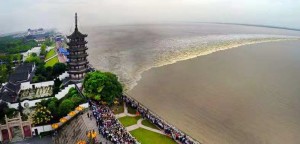 An image of the tidal bore shows its grandeur
An image of the tidal bore shows its grandeur
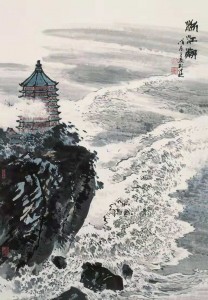 Watching the Bore has been popular for centuries
Watching the Bore has been popular for centuries
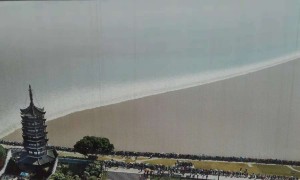 An aerial view of the Haining Bore provides an idea of the grandeur of this remarkable tidal wave
An aerial view of the Haining Bore provides an idea of the grandeur of this remarkable tidal wave



